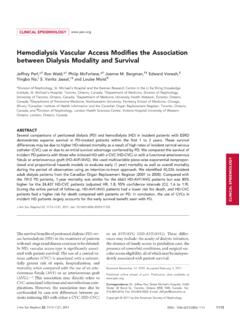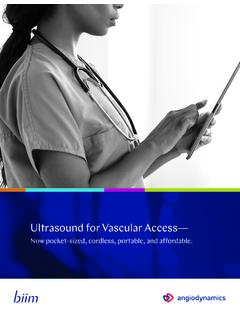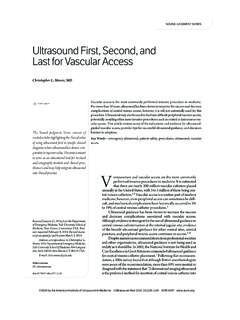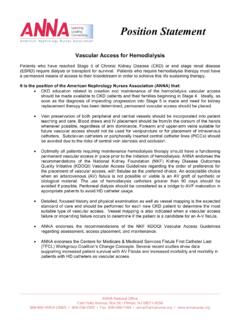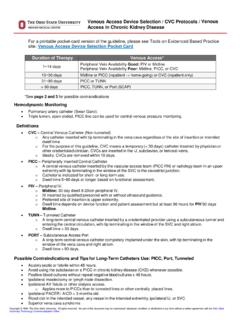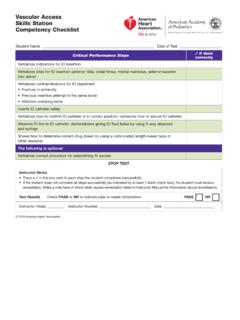Transcription of NHSN Dialysis Event Surveillance Protocol
1 Dialysis Event Surveillance Protocol February 2018 Page 1 of 22 Dialysis Event Surveillance Protocol Table of Contents Introduction 1 Dialysis Event Surveillance Overview 1 Event Definitions and Key Terms 2 Measure Definitions 4 vascular access Types 4 Reporting Instructions 5 Data Analysis 7 Reporting Resources 8 Appendices 9 Appendix A. Instructions for the Completion of the Dialysis Monthly Reporting Plan Form 9 Appendix B. Instructions for the Denominators for Dialysis Event Surveillance Form 12 Appendix C. Instructions for the Dialysis Event Surveillance Form 14 Introduction More than 425,000 patients are treated with maintenance hemodialysis in the United States.
2 Hemodialysis patients require a vascular access , which can be a catheter, or a graft or an enlarged blood vessel that can be punctured to remove and replace blood. Bloodstream infections and localized infections of the vascular access site cause substantial morbidity and mortality in hemodialysis patients. Hemodialysis vascular access types, in order of increasing risk of infection, include arteriovenous fistulas created from the patient s own blood vessels; arteriovenous grafts typically constructed from synthetic materials; tunneled central lines; and nontunneled central lines. Other access devices, such as catheter-graft hybrid devices, also exist. Because of frequent hospitalizations and receipt of antimicrobial drugs, hemodialysis patients are also at high risk for infection with antimicrobial-resistant bacteria.
3 Measuring and tracking rates of infection and utilizing this information is an important part of prevention. Infection prevention information is located at: Dialysis Event Surveillance Overview Each month, facilities report the number of hemodialysis outpatients who were dialyzed in the facility on the first two working days of the month, using the Denominators for Dialysis Event Surveillance form. This count is used to estimate the number of patient-months for which there is risk of healthcare-associated infection. Throughout the entire month, any and all outpatients who receive hemodialysis at the facility are monitored for three National Healthcare Safety Network (NHSN)-defined Dialysis events , which are: IV antimicrobial starts, positive blood cultures, and evidence of local access site infection.
4 Facilities use a Dialysis Event form to report the details of each Dialysis Event that occurred among patients. Before data can be reported, facilities must indicate that they are reporting according to this Protocol by saving a Monthly Reporting Plan and selecting DE. Completion of an Outpatient Dialysis Center Practices Survey is required annually. Dialysis Event Surveillance Protocol February 2018 Page 2 of 22 Setting: Surveillance occurs in outpatient hemodialysis centers. These centers may be attached to or affiliated with a hospital, but should serve hemodialysis outpatients. If other patients ( , inpatients, peritoneal Dialysis patients) are present, exclude them from Dialysis Event numerator and denominator reporting.
5 Population: Hemodialysis outpatients. Include transient patients Include peritoneal Dialysis patients or transplant patients undergoing temporary hemodialysis Include outpatients with acute kidney injury Requirements: Participating facilities are required to report data according to this Protocol , using the NHSN definitions described herein, to ensure data are uniformly reported across participating facilities. Report available data to NHSN within 30 to 60 days of the end of the month for which they were collected. If additional data become available after that period, users are expected to report the additional information retrospectively to ensure NHSN data are complete and accurate.
6 This may involve reporting additional Dialysis events and/or editing existing Event records. Event Definitions and Key Terms Dialysis Event : Three types of Dialysis events are reported by users: IV antimicrobial start; positive blood culture; and pus, redness, or increased swelling at the vascular access site. The following measures are also generated from the reported data: bloodstream infection (BSI), local access site infection (LASI), access -related bloodstream infection (ARBSI), and vascular access infection (VAI). 21 day rule: An Event reporting rule which reduces reporting of events that are likely to be related to the same patient problem. The rule is that 21 or more days must exist between two Dialysis events of the same type for the second occurrence to be reported as a separate Dialysis Event .
7 If fewer than 21 days have passed since the last reported Event of the same type, the subsequent Event of the same type is NOT considered a new Dialysis Event and therefore, it is not reported. The 21 day rule applies across calendar months. Refer to each Event definition for instructions on applying the 21 day by Event type. IV antimicrobial start: Report all starts of intravenous (IV) antibiotics or antifungals administered in an outpatient setting, regardless of the reason for administration ( , include IV antimicrobial starts unrelated to vascular access infection) and regardless of the duration of treatment. A start is defined as a single outpatient dose or first outpatient dose of a course.
8 Do not report IV antiviral starts. Report outpatient starts that are continuations of inpatient antimicrobial treatment. 21 day rule: There must be 21 or more days from the end of one reported IV antimicrobial course to the beginning of a second IV antimicrobial start for two starts to be reported as separate Dialysis events , even if different antimicrobials are used. If IV antimicrobials are stopped for fewer than 21 days and then restarted, the second start is NOT considered a new Dialysis Event and therefore, is not reported. For outpatient IV antimicrobial starts that are continuations of inpatient antimicrobial treatment, consider the start day to be the first day of outpatient administration.
9 Dialysis Event Surveillance Protocol February 2018 Page 3 of 22 Inter-facility patient transfers: If a patient at a Dialysis facility has an IV antimicrobial start and then transfers to another facility (as a transient or permanent patient) where the antimicrobial is continued, the second facility would report the IV antimicrobial start in their facility as well. Positive blood culture: Report all positive blood cultures from specimens collected as an outpatient or collected within one calendar day after a hospital admission. One calendar day after hospital admission includes positive blood cultures collected on the day of or the day following admission to the hospital.
10 Positive blood cultures meeting the criteria above should be reported regardless of whether or not a true infection is suspected or whether the infection is thought to be related to hemodialysis. 21 day rule: There must be 21 or more days between positive blood cultures for each positive blood culture to be considered a separate Dialysis Event , even if organisms are different. If two positive blood cultures (the first of which is reported) occur less than 21 days apart, the second positive blood culture is NOT considered a new Dialysis Event and therefore, is not reported. If different organisms grow from the subsequent positive blood cultures, add the new organisms to the first reported Event .










